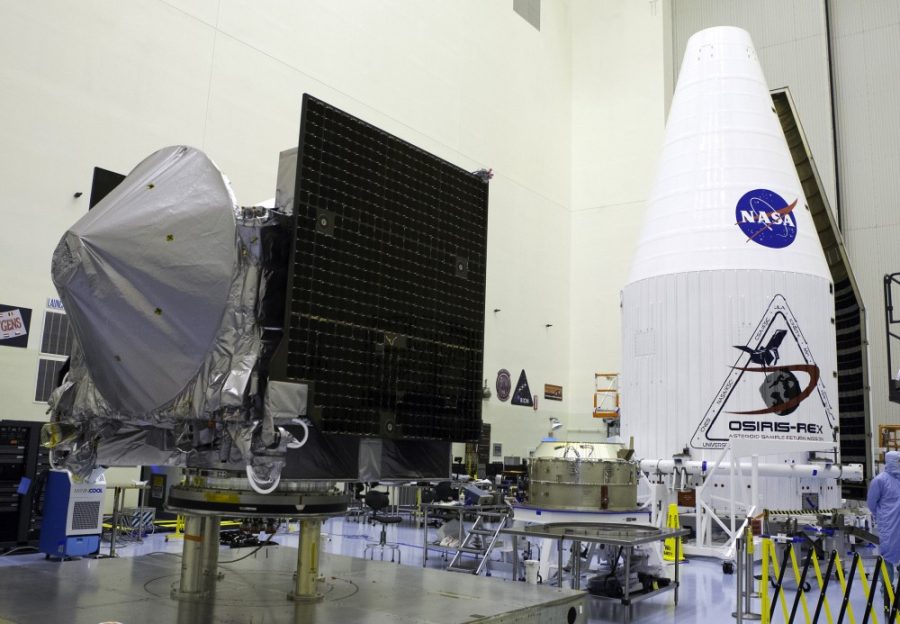In February, the spacecraft OSIRIS-REx will begin a search for Trojan asteroids—unique asteroids that share Earth’s orbit. The search will take place over a period of 10-12 days and will be conducted by a team at UA’s Lunar and Planetary Laboratory.
“[This search] gives us a chance to really practice a maneuver that we will execute again in 2 years and ensure that we’re performing it correctly, our cameras are working appropriately, and it’ll be an added plus if, during that search, we find a Trojan asteroid,” said Sara Knutson, OSIRIS-REx science operations lead engineer for the mission.
Trojan asteroids are asteroids that orbit the sun in the same orbit as Jupiter’s orbit, although they remain 60 degrees ahead or behind of Jupiter at all times, said Renu Malhotra, regents’ professor of planetary sciences. While the name ‘Trojan asteroids’ applies specifically to Jupiter, these same types of asteroids can be found among other planets such as Neptune, Mars, Uranus and Earth.

The idea to involve the OSIRIS-REx spacecraft in the search for Earth-Trojan asteroids was originally Malhotra’s.
“In my mind, the question has always been: what about Earth?” Malhotra said. “When I realized this OSIRIS-REx spacecraft was going to be traveling through a region of space that would be 60 degrees ahead of Earth in its own orbit, I suggested to Dante Lauretta, the principal investigator of this mission [and a professor of planetary science and cosmochemistry], that they could open up their cameras and take a few pictures to see if they could detect anything nearby.”
While NASA originally rejected Malhotra’s idea, they recently agreed to fund the asteroid search. The search for Earth-Trojan asteroids is more than just a scientific exploration; it also serves as an important calibration test for the spacecraft’s instruments.
“Everything was preliminarily calibrated here on the ground in a clean room, with a light source similar to the sun, so we have an idea of how our instruments would operate in space, in a cold-vacuum environment. But now we’re actually in space, and so we want to re-execute those same types of tests to make sure that our instruments are performing as we expected,” Knutson said.
In order to detect if there are any Earth-Trojan asteroids, the team will use their MapCam camera, taking about 50 images a day and pointing at the same spot in the sky two days in a row, Knutson said. An image processing team at the LPL then analyzes each image, searching for any unique features that might indicate an asteroid.
RELATED: To Infinity and Beyond: OSIRIS-REx deputy principal investigator retires after years of service
While Earth-Trojan asteroids are known by scientists, some researchers believe that there should be more than we currently see.
“There’s an excess in [craters] one hemisphere of the moon relative to the other hemisphere, and that excess led me to think that we don’t have a good explanation for that, and one possible explanation is that there’s this population we don’t know about, this population of asteroids that might be giving us impactors that preferentially hit the moon on one hemisphere,” Malhotra said.
If this new Earth-Trojan asteroid population does exist, it would mean a bonanza for our understanding of the population of near-Earth asteroids, Malhotra said. In the last 20 years, the U.S. government has mandated that NASA devote resources to studying asteroids that are close to the Earth’s orbit, as they pose a potential hazard to national security.
“This would be the big gap, our blind spot that we have not seen, and I’m sure that would be totally astonishing to astronomers, that there’s a large population [of asteroids] here,” Malhotra said.

If the spacecraft doesn’t find any evidence of the asteroids, it will raise further questions about Earth’s early history.
“In principle, the stability of the orbits in [the Earth’s] region is quite large, so if there was a primordial population of asteroids that survived, if the Earth formed in a similar way as our theories say, then there ought to be a surviving population of Earth-Trojans,” Malhotra said.
According to Malhotra, other possible explanations for the missing asteroids could be a past perturbation of Earth’s orbit or a low population density of asteroids.
RELATED: UA experts weigh-in on NASA’s EM Drive
This asteroid search is the first in a series of important maneuvers the spacecraft will undergo this year, including its six-month instrument calibration in March and the Earth gravity assist in September, Knutson said.
Knutson also mentioned another important aspect of the asteroid search, referring to the team of students who will be heavily involved throughout the entire process.
Both undergraduate and graduate students help with everything from writing the software and programming instruments to identifying unique features in the images the MapCam takes.
All of this helps the team to prepare for the procedures they will perform when OSIRIS-REx reaches its final destination.
“Right now it’s just unique features in the sky, but two years from now it will be identifying unique features on the surface of Bennu, [OSIRIS-REx’ target asteroid],” Knutson said.
The OSIRIS-REx team hopes to release the results of the Earth-Trojan mission shortly after the search is completed in mid-February.
Follow Hannah Dahl on Twitter.









